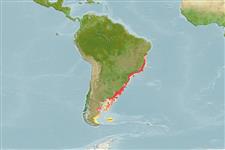Common names from other countries
>
Pleuronectiformes (Flatfishes) >
Paralichthyidae (Large-tooth flounders)
Etymology: Paralichthys: Greek, para = the side of + Greek, ichthys = fish + Greek, suffix, oides = similar to (Ref. 45335).
Environment: milieu / climate zone / depth range / distribution range
Sinh thái học
Biển; Thuộc về nước lợ gần đáy; Mức độ sâu 0 - 40 m (Ref. 26375). Subtropical; 12°S - 54°S
Southwest Atlantic: Brazil. Does not occur in Argentina nor in Uruguay (Ref. 43588).
Bộ gần gũi / Khối lượng (Trọng lượng) / Age
Maturity: Lm ? range ? - ? cm
Max length : 100.0 cm TL con đực/không giới tính; (Ref. 26375); common length : 40.0 cm TL con đực/không giới tính; (Ref. 6077); Khối lượng cực đại được công bố: 12.0 kg (Ref. 26375)
Các tia vây lưng cứng (tổng cộng) : 0; Các vây lưng mềm (tổng cộng) : 68 - 86; Tia cứng vây hậu môn: 0; Tia mềm vây hậu môn: 52 - 67. Pectoral fins small, about two times head on ocular side, 2.7-3.0 time head on blind side. Pelvic fins about equal in size and shape on both sides. Caudal fin double truncate (Ref. 27363).
Inhabits coastal areas, in bays and estuaries (Ref. 36453). Found over sandy or muddy substrate. Apparently, reproduction occurs during summer in small groups of 3-15 individuals. Adults are solitary. This species is very much appreciated for its taste and high commercial value.
Life cycle and mating behavior
Maturities | Sự tái sinh sản | Spawnings | Egg(s) | Fecundities | Ấu trùng
Distinct pairing (Ref. 205).
Cervigón, F. and W. Fischer, 1979. INFOPESCA. Catálogo de especies marinas de interes economico actual o potencial para América Latina. Parte 1. Atlántico centro y suroccidental. FAO/UNDP, SIC/79/1. 372 p. FAO, Rome. (Ref. 6077)
IUCN Red List Status (Ref. 130435)
CITES (Ref. 128078)
Not Evaluated
Threat to humans
Harmless
Human uses
Các nghề cá: Tính thương mại; cá để chơi: đúng
Các công cụ
Special reports
Download XML
Các nguồn internet
Estimates based on models
Preferred temperature (Ref.
115969): 11.7 - 26.1, mean 16.1 (based on 150 cells).
Phylogenetic diversity index (Ref.
82804): PD
50 = 0.5000 [Uniqueness, from 0.5 = low to 2.0 = high].
Bayesian length-weight: a=0.00646 (0.00384 - 0.01085), b=3.16 (3.02 - 3.30), in cm Total Length, based on LWR estimates for this species & Genus-body shape (Ref.
93245).
Mức dinh dưỡng (Ref.
69278): 4.4 ±0.6 se; based on size and trophs of closest relatives
Thích nghi nhanh (Ref.
120179): Trung bình, thời gian nhân đôi của chủng quần tối thiểu là 1.4 - 4.4 năm (Preliminary K or Fecundity.).
Fishing Vulnerability (Ref.
59153): High vulnerability (60 of 100).
